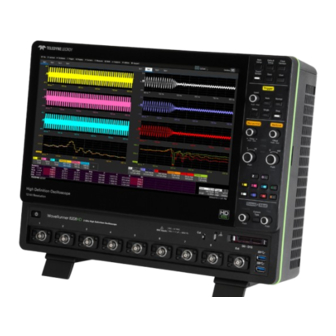
Table of Contents
Advertisement
Quick Links
Advertisement
Table of Contents

Summarization of Contents
Introduction to WaveRunner/MDA 8000HD
Introducing MDA/WaveRunner 8000HD Oscilloscopes
Overview of the oscilloscope's capabilities and features, including HD4096 technology and channel options.
Safety Precautions and Symbols
Essential safety guidelines, warnings, and visual indicators for proper instrument operation.
Overview of Oscilloscope Features
Front Panel Component Identification
Identifies key physical components and ports located on the oscilloscope's front panel.
Powering On and Off Procedures
Step-by-step guide for operating the oscilloscope's power functions and standby modes.
Back and Side Panel Connectivity
Details of ports and connectors found on the oscilloscope's rear and side panels.
Connecting External Devices and Systems
Instructions for interfacing with printers, external monitors, and network connections.
Probe and Digital Leadset Compatibility
Information on supported probes and the integration of digital leadsets for MSO options.
Front Panel Controls and Operation
Explanation of front panel controls, shortcut buttons, and operational functions.
Touch Screen Display Interface Guide
Comprehensive overview of the touch screen display elements, interactions, and controls.
Display Navigation and Control Elements
Understanding the menu bar, toolbars, and descriptor boxes for efficient navigation.
Basics of Oscilloscope Operation
Display Configuration and Grid Modes
Customizing grid modes and display styles for optimal waveform viewing.
Extended Display and Trace Properties
Configuring secondary displays and adjusting trace intensity and persistence.
Trace Management and Parameter Adjustment
Using trace descriptors, context menus, and adjusting trace parameters.
MAUI OneTouch Gesture Operations
Utilizing intuitive touch gestures for efficient oscilloscope setup and control.
Setup Copying and Source Selection
Methods for copying trace setups and modifying measurement sources.
Cursor Measurements and Trigger Adjustments
Positioning cursors for measurements and altering trigger settings.
Trace Memory Storage and Panning
Saving traces to memory and panning waveforms for detailed analysis.
Zoom Trace Creation and Management
Generating, managing, and turning off zoom traces for magnification.
Vertical Controls and Scale Settings
Adjusting vertical scale, offset, and probe compensation settings.
Digital Trace Configuration
Setting up digital traces and bus displays using front panel controls.
Digital Trace Setup via Touch Screen
Configuring digital traces, logic families, and line labels using the touch interface.
Horizontal (Timebase) Control Functions
Adjusting horizontal scale, trigger delay, and sample rate settings.
Timebase and Sampling Mode Configuration
Setting timebase modes, sampling, and navigation references.
Navigating Long Acquisitions with Delay
Analyzing long acquisitions in the Analysis Zone using horizontal delay.
Zoom Trace Analysis Techniques
Utilizing zoom traces for detailed examination of specific signal regions.
Navigation Reference Settings Explained
Understanding how display centering adjusts with Time/div changes.
Lock to Trigger Navigation Reference
Maintaining trigger point stability when changing Time/div settings.
Trigger Controls and Setup Options
Understanding trigger modes, types, and front panel setup.
Trigger Configuration via Touch Screen
Setting trigger parameters like type, source, and coupling via touch.
Front Panel Zoom Trace Creation
Creating zoom traces using the front panel for magnified views.
Touch Screen Zoom Trace Configuration
Defining zoom regions and adjusting parameters via the touch interface.
Cursor Measurement and Positioning
Using cursors for accurate waveform measurements and repositioning.
Waveform Measurements and Statistics
Performing measurements and displaying statistical data for acquired waveforms.
Math Trace Operations and Analysis
Applying mathematical functions to create and analyze new traces.
Memories and Reference Waveform Usage
Storing, recalling, and analyzing reference waveforms for comparison.
Saving and Sharing Data Methods
Managing setups, waveforms, and screen captures for analysis and transfer.
Maintenance Procedures
Cleaning, Software Activation, and Calibration
Procedures for instrument cleaning, option activation, and calibration.
Firmware Updates and User Management
Steps for updating firmware and managing Windows user accounts.
Service, Support, and Warranty Details
Information on instrument service, technical support, and warranty terms.
Reference Information
Software Options Overview and Functionality
Descriptions of available software options for enhanced oscilloscope functionality.
Documentation, Support, and Warranty
Accessing online help, manuals, technical support, and warranty information.
Certifications, Compliance, and Contacts
Details on product certifications, compliance standards, and regional contacts.
Regional Contacts and Compliance Marks
Contact information for different regions and relevant compliance marks.
















Need help?
Do you have a question about the MDA 8000HD and is the answer not in the manual?
Questions and answers